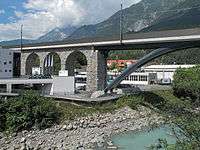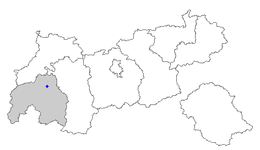Landeck
| Landeck | ||
|---|---|---|
 | ||
| ||
 Landeck Location within Austria | ||
Location of Landeck within Tyrol
| ||
| Coordinates: 47°08′00″N 10°34′00″E / 47.13333°N 10.56667°ECoordinates: 47°08′00″N 10°34′00″E / 47.13333°N 10.56667°E | ||
| Country | Austria | |
| State | Tyrol | |
| District | Landeck | |
| Government | ||
| • Mayor | Wolfgang Jörg (ÖVP) | |
| Area | ||
| • Total | 15.9 km2 (6.1 sq mi) | |
| Elevation | 816 m (2,677 ft) | |
| Population (1 January 2016)[1] | ||
| • Total | 7,773 | |
| • Density | 490/km2 (1,300/sq mi) | |
| Time zone | CET (UTC+1) | |
| • Summer (DST) | CEST (UTC+2) | |
| Postal code | 6500 | |
| Area code | 05442 | |
| Vehicle registration | LA | |
| Website | www.landeck.tirol.gv.at | |
Landeck is a town in the Austrian state of Tyrol, the capital of the district of Landeck.
Geography
Landeck is located in the Tyrolean Oberland in the west of the state at an elevation of about 820 m (2,690 ft). The town is situated in the valley of the Inn River at the confluence with the Sanna tributary, between the Lechtal Alps, part of the Northern Limestone Alps in the north, and the Ötztal Alps and Samnaun Alps ranges of the Central Eastern Alps in the south.
The Inn valley is an important transport route from Tyrol to the west across the Arlberg massif. In the south, the Reschen Pass at the main chain of the Alps leads to the Vinschgau region in Italian South Tyrol.
History

In ancient times, the Via Claudia Augusta ran across the Reschen Pass and through the Inn Valley Landeck, connecting the Roman Italia peninsula with the Raetia province conquered in 15 BC. Throughout the Middle Ages the valley remained an important junction of trade routes leading to Augsburg via the Fern Pass and westwards across the Arlberg. From the late 13th century onwards the Meinhardiner counts of Tyrol controlled the area from their stronghold at Landeck Castle. Until 1918, LANDECK IN TIROL (named LANDEK before 1867, and LANDECK until 1893) was part of the Austrian monarchy (Austria side after the compromise of 1867), head of the district of the same name, one of the 21 Bezirkshauptmannschaften in the Tyrol province.[2]
From 1782 a first pass road was built across the Arlberg at the behest of Emperor Joseph II, it was significantly enlarged until 1824. Landeck received access to the Arlberg railway in 1883. In 1904 it was elevated to the status of a market town, and finally was granted town privileges in 1923.
Landeck was also used as a military base for Austrian mountain troops before the second world war, later, they became a unit of the German Wehrmacht.
During the Austrian Anschluss to Nazi Germany, Landeck was merged with neighboring Zams in 1939; however, both municipalities again split after World War II. Landeck was also the site of a UNRRA displaced person camp in the French sector of Allied-occupied Austria.[3]
Population
| Historical population | ||
|---|---|---|
| Year | Pop. | ±% |
| 1869 | 1,398 | — |
| 1880 | 1,537 | +9.9% |
| 1890 | 1,944 | +26.5% |
| 1900 | 2,227 | +14.6% |
| 1910 | 3,569 | +60.3% |
| 1923 | 4,106 | +15.0% |
| 1934 | 4,113 | +0.2% |
| 1939 | 5,542 | +34.7% |
| 1951 | 5,615 | +1.3% |
| 1961 | 6,514 | +16.0% |
| 1971 | 7,475 | +14.8% |
| 1981 | 7,317 | −2.1% |
| 1991 | 7,411 | +1.3% |
| 2001 | 7,632 | +3.0% |
| 2011 | 7,713 | +1.1% |
Personalities
- Raoul Schrott (born 1964), author
Transport

Landeck-Zams station is an important hub for regional coach lines as well as a noteworthy stop for international trains on the Arlberg railway from the Tyrolean capital Innsbruck via the Arlberg Railway Tunnel to Bludenz in Vorarlberg. Landeck is also the terminus of the parallel Inn Valley Autobahn, which continues as S 16 Schnellstraße to the Arlberg Road Tunnel in the west.
References
- ↑ Statistik Austria - Bevölkerung zu Jahresbeginn 2002-2016 nach Gemeinden (Gebietsstand 1.1.2016) for Landeck.
- ↑ Die postalischen Abstempelungen auf den österreichischen Postwertzeichen-Ausgaben 1867, 1883 und 1890, Wilhelm KLEIN, 1967
- ↑ Eisterer, Klaus (1991). Französische Besatzungspolitik Tirol und Vorarlberg 1945/46-Innsbrucker Forschungen zur Zeitgeschichte Band 9 (in German). Innsbruck: Haymon Verlag. p. 104.
External links
| Wikimedia Commons has media related to Landeck (Tyrol). |

